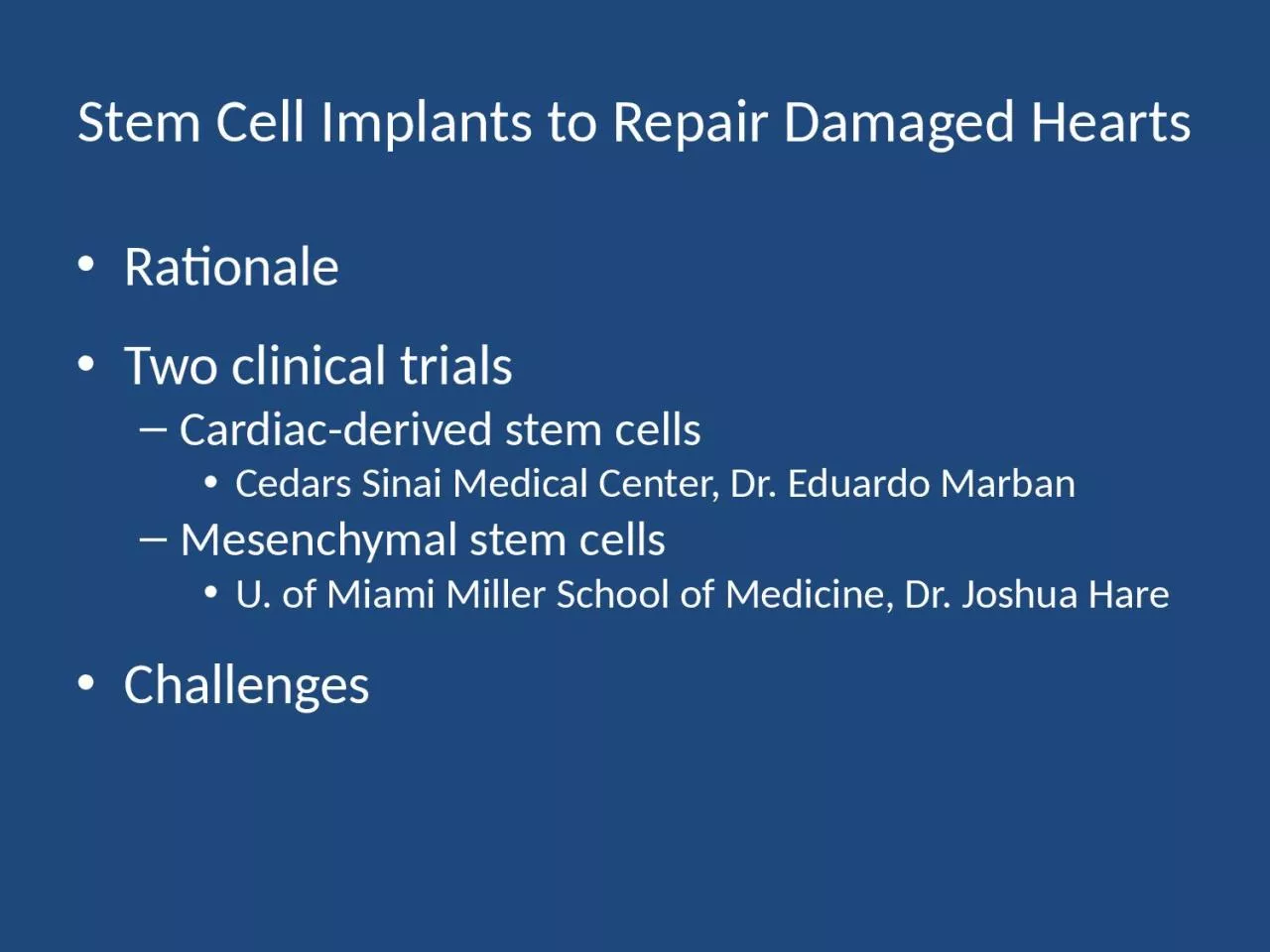

Rationale Two clinical trials Cardiacderived stem cells Cedars Sinai Medical Center Dr Eduardo Marban Mesenchymal stem cells U of Miami Miller School of Medicine Dr Joshua Hare Challenges ID: 1007360
Download Presentation The PPT/PDF document "Stem Cell Implants to Repair Damaged Hea..." is the property of its rightful owner. Permission is granted to download and print the materials on this web site for personal, non-commercial use only, and to display it on your personal computer provided you do not modify the materials and that you retain all copyright notices contained in the materials. By downloading content from our website, you accept the terms of this agreement.
1. Stem Cell Implants to Repair Damaged HeartsRationaleTwo clinical trialsCardiac-derived stem cellsCedars Sinai Medical Center, Dr. Eduardo MarbanMesenchymal stem cellsU. of Miami Miller School of Medicine, Dr. Joshua Hare Challenges
2. Coronary Artery DiseaseCardiac MuscleDysfunctionCongestive Heart FailureShortened survivalFrequent hospitalizationsBreathlessnessFatigueVolume overloadHeart Valve DiseaseHypertensionIdiopathic
3. Intrinsic Response to CHFIncreased sympathetic stimulationIncreased heart rateIncreased contractile forceIncreased renin-angiotensin-aldosteroneIncreased blood pressureSalt retentionInitial compensation, eventual self-defeating
4. Current Treatment OptionsPrevent new damageDiuretics – improve salt excretionDecrease cardiac workloadNeurohumoral blockadeTransplantation/mechanical devicesNone of these address the primary problem– the loss of living, working heart muscle
5. TRADITIONAL TEACHINGAll heart cells are terminally differentiated The heart cells we have now are those we were born with, and we will not have any othersOnly responses to injury, e.g. a heart attackHypertrophy (increase in cell size)Dilation (cell slippage)Scar formation*
6.
7. Female hearts (with XX chromosomes) transplanted into males (XY chromosomes)Y chromosome (and other markers) in heart muscle cells and coronary arteries, indicating new heart muscle cells were formed from male bone marrow
8. From: Dimmeler S et al, JCI 2005; 115:572-83
9. From: Dimmeler S et al, JCI 2005; 115:572-83
10. Cardiosphere-Derived Cells (CDCs)200 mm1100 mm32200 mmExplants (1)BiopsyCardiosphere-forming cells2,3Cardiospheres (4)Cardiosphere-derived cells (CDCs, 5,6)200 mm4% of total0102030405060708090100c-Kit+CD34+CD31+ CD90+CD105+6100 mm5
11. CADUCEUS: The Cardiosphere-Derived Autologous Stem Cells to Reduce Ventricular Dysfunction TrialPhase I/II randomized, prospective, controlled study - with Cedars Sinai Medical CenterAcute MI with resultant LV dysfunction (LVEF 25%-45%)Intracoronary infusion of autologous CDCs in infarct-related artery vs. optimal medical therapyPrimary outcome: Safety Secondary outcome: Efficacy (Scar size, chamber size, LV function as assessed by gadolinium-enhanced MRI)Lancet 2012; 379(9819):895-904.
12. CADUCEUS Study Time CourseLancet 2012; 379(9819):895-904.In patients randomized to receive CDCs:Endomyocardial biopsy performed within one month of MI after screening MRI to r/o infarction of right ventricular septumAutologous CDCs infused in infarct-related artery 4-6 weeks later using angioplasty balloon during intermittent balloon inflationTwo dose strata: 12.5 million, 25 million4 weeks4-6 weeks6 months6 monthsMyocardial infarctionBiopsyCDC infusionBaselineMRI6 monthMRI12 monthMRI
13. Intracoronary CDC Infusion Reduces Gd-Enhancement after MI Baseline 6 months Control CDCsLancet 2012 379(9819):895-904.For CDC-treated patients ΔScar: Mean -8.4g (28%) at 6 mosMean -12.9g (42%) at 12 mos
14. Effects on LV Function and RemodelingLancet 2012 379(9819):895-904.Regional Function in Infarct Zone Controls CDCsLV Volumes
15. Phase I/II randomized, prospective, controlled study - with University of Miami Miller School of MedicineIschemic left ventricular dysfunctionRandomized trial of autologous (from the patient) vs allogeneic (from a donor) mesenchymal stem cellsThree dose strata (20, 100, 200) million cellsPrimary outcome: SafetyPOSEIDON (The PercutaneOus StEm Cell Injection Delivery Effects On Neomyogenesis Study)JAMA 2012;308(22):2369-79
16. Biocardia, Inc; Rodriguez-Porcel, M. et al. J Am Coll Cardiol 2008;51:595-597Biocardia Helix Intramyocardial Stem Cell Injection Catheter
17. Both allogeneic and autologous MSCs were safe and well toleratedLow rate of sensitivization to allogeneic cells (1/15)No significant difference between MSCs in effects on LVEF, infarct size, or LV remodelingJAMA 2012;308(22):2369-79POSEIDON (The PercutaneOus StEm Cell Injection Delivery Effects On Neomyogenesis Study)
18. Challenges/Opportunities for Cardiac Stem Cell TherapiesClinical studies of bone marrow and cardiac-derived stem cells are safe, but beneficial effects are modest to dateHow can the modest effects of stem cell therapy for the heart be improved upon?
19. Challenges: Where to Get the Cells(From the patient or from a donor)From the patient (autologous)Advantage: no immune response, perfect matchDisadvantages:“Host” factor (age, disease)Requires harvesting (risks), isolation, and expansion (time, expense) of patient’s cells
20. Circulation 2003;108:457-463JACC 2005;45:1441-8JACC 2003:42:2073-2080
21. InjuryDecreased InflammationContinued inflammation OLDERLARGE INJURYYOUNGER,SMALL INJURYInflammationRecruitment of Stem CellsRepair and RegenerationLess effective repairAtherosclerosisScar
22. Challenge in Obtaining Cells From Patient: Heart Biopsy
23. Challenges: Where to Get the CellsFrom a donor (allogeneic)Advantage: Young healthy donorReady availability, no biopsy risk, no time delayLess expensive, scalableDisadvantage:Immune attack on cellsGenerates antibodies in recipient which may preclude further cell administration and heart transplantation
24. Challenges: How to Give the Cells Into a coronary artery OR direct injection into the heartIntra-coronarySize limitation for type of cells which can be usedRequires coronary artery catheterizationRequires an open artery through which to infuse the cellsRequires trans-vascular migration of the cellsIntra-myocardial injection Risk of perforationUncertainty regarding injection site
25. Challenges: How Long the Cells Are Able to Function After They are GivenLimited retention of cells following administrationWashoutDilutionImmune attack if allogeneic“Hostile” environmentBrief duration for cells to have a benefitUncertainty regarding time of administration
26. Present FocusParacrine hypothesis: There are intrinsic, natural repair processes, which are overwhelmed in the setting of major injury and incapable of complete repair.The primary mechanism responsible for stem cell benefit is not the stem cells themselves becoming new heart muscle and artery cells, but rather soluble factors released by stem cells (paracrine factors) which turn “on/up” these intrinsic mechanisms.“Rejuvenate” old stem cells
27. SummaryCardiac dysfunction is widespread, associated with significant mortality risk and impaired quality of lifeTreatment options are limitedClinical need for and therapeutic promise of stem cell therapies are great; significant opportunities for progressSignificant challenges remain; translation to the clinical setting is just beginningSafety and efficacy assessments require careful oversight and multi-disciplinary collaboration